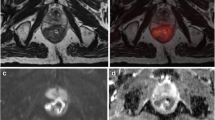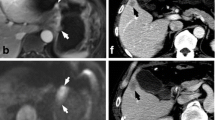Abstract
Purpose
The aim of this study was to explore possible correlations among different imaging features from 2-deoxy-2-[18F]fluoro-D-Glucose positron emission tomography/magnetic resonance imaging (PET/MRI) in rectal cancer (RC).
Procedures
RC patients who underwent PET/MRI were enrolled. A region of interest (ROI) was drawn around each primary RC on PET/MRI images (PET, pelvic axial T2w, and apparent diffusion coefficient maps (ADC)). Multiple imaging features were assessed, and Pearson’s correlation was used to explore possible correlations among them.
Results
A total of 13 patients were included, mean age 56.1 years old, 6 females. A strong inverse correlation was observed between SUVpeak and ADCmean values, MTV and T2 sphericity, MTV and ADC sphericity, MTV and T2 entropy, and TLG and ADC sphericity. There was also strong direct correlation between PET entropy and ADC sphericity.
Conclusions
In conclusion, several clinically relevant correlations were observed between PET and MRI imaging features. These findings show how the use of both modalities provides complementary information.






Similar content being viewed by others
References
Ferlay J, Colombet M, Soerjomataram I, Mathers C, Parkin DM, Piñeros M, Znaor A, Bray F (2019) Estimating the global cancer incidence and mortality in 2018: GLOBOCAN sources and methods. Int J Cancer 144:1941–1953. https://doi.org/10.1002/ijc.31937
Siegel RL, Miller KD, Jemal A (2019) Cancer statistics, 2019. CA Cancer J Clin 69:7–34. https://doi.org/10.3322/caac.21551
Aklilu M, Eng C (2011) The current landscape of locally advanced rectal cancer. Nat Rev Clin Oncol 8:649–659. https://doi.org/10.1038/nrclinonc.2011.118
Van Cutsem E, Verheul HMW, Flamen P et al (2016) Imaging in colorectal cancer: progress and challenges for the clinicians. Cancers (Basel). https://doi.org/10.3390/cancers8090081
Horvat N, Petkovska I, Gollub MJ (2018) MR imaging of rectal cancer. Radiol Clin N Am 56:751–774. https://doi.org/10.1016/j.rcl.2018.04.004
National Comprehensive Cancer Network. Rectal Cancer (Version 3.2018). https://www.nccn.org/professionals/physician_gls/pdf/rectal.pdf.
Catalano OA, Coutinho AM, Sahani DV, Vangel MG, Gee MS, Hahn PF, Witzel T, Soricelli A, Salvatore M, Catana C, Mahmood U, Rosen BR, Gervais D (2017) Colorectal cancer staging: comparison of whole-body PET/CT and PET/MR. Abdom Radiol (NY) 42:1141–1151. https://doi.org/10.1007/s00261-016-0985-3
Brendle C, Schwenzer NF, Rempp H, Schmidt H, Pfannenberg C, la Fougère C, Nikolaou K, Schraml C (2016) Assessment of metastatic colorectal cancer with hybrid imaging: comparison of reading performance using different combinations of anatomical and functional imaging techniques in PET/MRI and PET/CT in a short case series. Eur J Nucl Med Mol Imaging 43:123–132. https://doi.org/10.1007/s00259-015-3137-z
Antoch G, Bockisch A (2009) Combined PET/MRI: a new dimension in whole-body oncology imaging? Eur J Nucl Med Mol Imaging 36(Suppl 1):S113–S120. https://doi.org/10.1007/s00259-008-0951-6
van Helden EJ, Vacher YJL, van Wieringen WN, van Velden F, Verheul HMW, Hoekstra OS, Boellaard R, Menke-van der Houven van Oordt C (2018) Radiomics analysis of pre-treatment [18F]FDG PET/CT for patients with metastatic colorectal cancer undergoing palliative systemic treatment. Eur J Nucl Med Mol Imaging 45:2307–2317. https://doi.org/10.1007/s00259-018-4100-6
Lovinfosse P, Polus M, Van Daele D et al (2018) FDG PET/CT radiomics for predicting the outcome of locally advanced rectal cancer. Eur J Nucl Med Mol Imaging 45:365–375. https://doi.org/10.1007/s00259-017-3855-5
Amorim BJ, Hong TS, Blaszkowsky LS, Ferrone CR, Berger DL, Bordeianou LG, Ricciardi R, Clark JW, Ryan DP, Wo JY, Qadan M, Vangel M, Umutlu L, Groshar D, Cañamaques LG, Gervais DA, Mahmood U, Rosen BR, Catalano OA (2019) Clinical impact of PET/MR in treated colorectal cancer patients. Eur J Nucl Med Mol Imaging 46:2260–2269. https://doi.org/10.1007/s00259-019-04449-7
Zwanenburg A, Leger S, Vallières M, Löck S (2016) Image biomarker standardisation initiative. arXiv:1612.07003
Jeong JH, Cho IH, Chun KA, Kong EJ, Kwon SD, Kim JH (2016) Correlation between apparent diffusion coefficients and standardized uptake values in hybrid (18)F-FDG PET/MR: preliminary results in rectal cancer. Nucl Med Mol Imaging 50:150–156. https://doi.org/10.1007/s13139-015-0390-9
Gu J, Khong P-L, Wang S, Chan Q, Law W, Zhang J (2011) Quantitative assessment of diffusion-weighted MR imaging in patients with primary rectal cancer: correlation with FDG-PET/CT. Mol Imaging Biol 13:1020–1028. https://doi.org/10.1007/s11307-010-0433-7
Gauthé M, Richard-Molard M, Fayard J, Alberini JL, Cacheux W, Lièvre A (2017) Prognostic impact of tumour burden assessed by metabolic tumour volume on FDG PET/CT in anal canal cancer. Eur J Nucl Med Mol Imaging 44:63–70. https://doi.org/10.1007/s00259-016-3475-5
Suzuki Y, Okabayashi K, Hasegawa H, Tsuruta M, Shigeta K, Murakami K, Kitagawa Y (2016) Metabolic tumor volume and total lesion glycolysis in PET/CT correlate with the pathological findings of colorectal cancer and allow its accurate staging. Clin Nucl Med 41:761–765. https://doi.org/10.1097/RLU.0000000000001332
Ganeshan B, Miles KA, Young RCD, Chatwin CR (2009) Texture analysis in non-contrast enhanced CT: impact of malignancy on texture in apparently disease-free areas of the liver. Eur J Radiol 70:101–110. https://doi.org/10.1016/j.ejrad.2007.12.005
Han Y-H, Jeong H-J, Sohn M-H, Lim ST (2018) Clinical value of intratumoral metabolic heterogeneity in [18F]FDG PET/CT for prediction of recurrence in patients with locally advanced colorectal cancer. Q J Nucl med Mol imaging 62:445–452. https://doi.org/10.23736/S1824-4785.16.02862-4
Bundschuh RA, Dinges J, Neumann L, Seyfried M, Zsótér N, Papp L, Rosenberg R, Becker K, Astner ST, Henninger M, Herrmann K, Ziegler SI, Schwaiger M, Essler M (2014) Textural parameters of tumor heterogeneity in 18F-FDG PET/CT for therapy response assessment and prognosis in patients with locally advanced rectal cancer. J Nucl Med 55:891–897. https://doi.org/10.2967/jnumed.113.127340
Oh JE, Kim MJ, Lee J et al (2019) Magnetic resonance-based texture analysis differentiating KRAS mutation status in rectal cancer. Cancer Res Treat. https://doi.org/10.4143/crt.2019.050
Yi X, Pei Q, Zhang Y, Zhu H, Wang Z, Chen C, Li Q, Long X, Tan F, Zhou Z, Liu W, Li C, Zhou Y, Song X, Li Y, Liao W, Li X, Sun L, Pei H, Zee C, Chen BT (2019) MRI-based radiomics predicts tumor response to neoadjuvant chemoradiotherapy in locally advanced rectal cancer. Front Oncol 9:552. https://doi.org/10.3389/fonc.2019.00552
Shayesteh SP, Alikhassi A, Fard Esfahani A, Miraie M, Geramifar P, Bitarafan-Rajabi A, Haddad P (2019) Neo-adjuvant chemoradiotherapy response prediction using MRI based ensemble learning method in rectal cancer patients. Phys Med 62:111–119. https://doi.org/10.1016/j.ejmp.2019.03.013
Author information
Authors and Affiliations
Corresponding author
Ethics declarations
Conflict of Interest
The authors declare that they have no conflict of interest.
Additional information
Publisher’s Note
Springer Nature remains neutral with regard to jurisdictional claims in published maps and institutional affiliations.
Rights and permissions
About this article
Cite this article
Amorim, B.J., Torrado-Carvajal, A., Esfahani, S.A. et al. PET/MRI Radiomics in Rectal Cancer: a Pilot Study on the Correlation Between PET- and MRI-Derived Image Features with a Clinical Interpretation. Mol Imaging Biol 22, 1438–1445 (2020). https://doi.org/10.1007/s11307-020-01484-x
Published:
Issue Date:
DOI: https://doi.org/10.1007/s11307-020-01484-x




